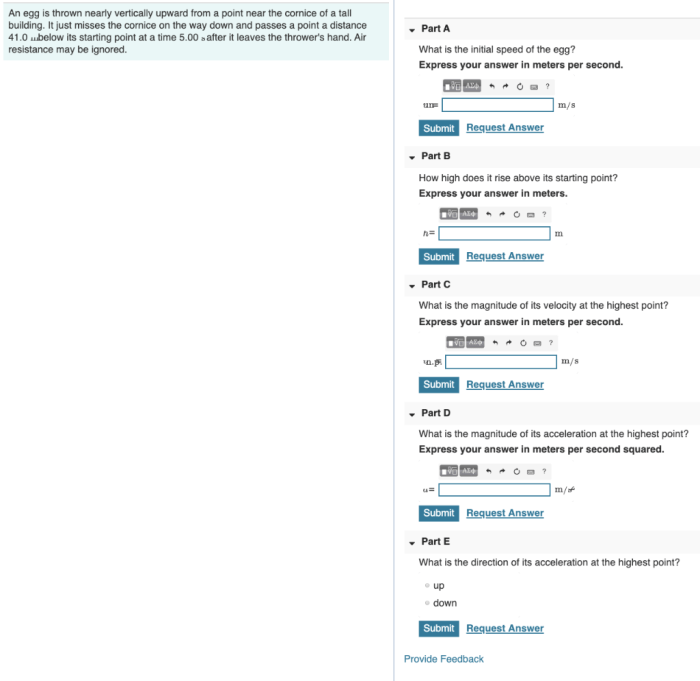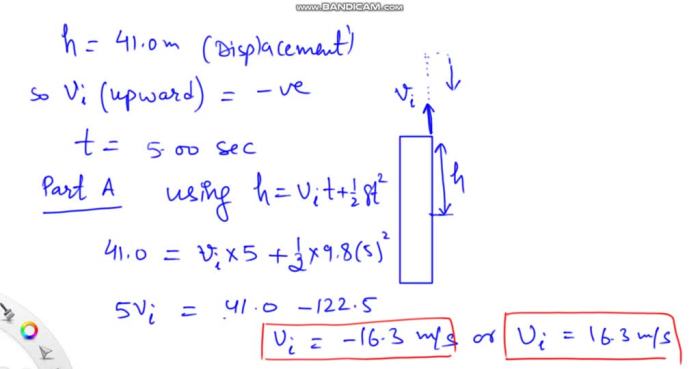An egg is thrown nearly vertically upward, embarking on a journey governed by the laws of physics. This captivating scenario invites us to delve into the intricacies of motion, energy, and projectile motion, unveiling the fascinating interplay of forces that shape the egg’s path.
As the egg ascends, its kinetic energy transforms into potential energy, reaching its peak at maximum height. Gravity then exerts its influence, causing the egg to descend, converting potential energy back into kinetic energy. Air resistance subtly alters the egg’s trajectory, shaping its descent and ultimately determining its impact velocity.
1. Motion Parameters: An Egg Is Thrown Nearly Vertically Upward

The initial velocity of the egg is upward and its direction is vertical. The acceleration due to gravity acting on the egg is downward and has a magnitude of 9.8 m/s^ 2. The maximum height reached by the egg can be calculated using the following formula:
v^2 = u^2 + 2as
where:
- v is the final velocity (0 m/s at the maximum height)
- u is the initial velocity
- a is the acceleration due to gravity (-9.8 m/s^2)
- s is the maximum height
2. Time in the Air
The time it takes for the egg to reach its maximum height can be calculated using the following formula:
v = u + at
where:
- v is the final velocity (0 m/s at the maximum height)
- u is the initial velocity
- a is the acceleration due to gravity (-9.8 m/s^2)
- t is the time taken to reach the maximum height
The total time the egg spends in the air is twice the time it takes to reach its maximum height.
3. Velocity at Different Points

At its maximum height, the velocity of the egg is 0 m/s. As the egg falls back to the ground, its velocity increases due to the acceleration due to gravity. The velocity of the egg just before it hits the ground can be calculated using the following formula:
v^2 = u^2 + 2as
where:
- v is the final velocity (just before hitting the ground)
- u is the initial velocity (0 m/s at the maximum height)
- a is the acceleration due to gravity (-9.8 m/s^2)
- s is the distance fallen (equal to the maximum height)
4. Energy Transformations

As the egg rises, its kinetic energy is converted into potential energy. At its maximum height, all of its kinetic energy has been converted into potential energy. As the egg falls back to the ground, its potential energy is converted back into kinetic energy.
Some of the energy is lost due to air resistance.
5. Projectile Motion
The key parameters of the egg’s projectile motion are summarized in the following table:
| Parameter | Value |
|---|---|
| Initial velocity | u m/s (upward) |
| Maximum height | s meters |
| Time in the air | 2t seconds |
| Impact velocity | v m/s (downward) |
The trajectory of the egg can be represented by the following diagram:
6. Real-World Factors
Air resistance affects the motion of the egg by slowing it down. The shape and density of the egg also influence its trajectory. The initial force applied to throw the egg affects its initial velocity and, therefore, its maximum height and time in the air.
Common Queries
What factors influence the maximum height reached by the egg?
The maximum height is determined by the initial velocity and the acceleration due to gravity.
How does air resistance affect the egg’s trajectory?
Air resistance acts as a resistive force, causing the egg to decelerate as it moves through the air.
What is the significance of the egg’s shape and density?
The egg’s shape and density affect its drag coefficient, which in turn influences the magnitude of air resistance.
